View in other NatureServe Network Field Guides
NatureServe
Montana
Utah
Wyoming
Idaho
Wisconsin
British Columbia
South Carolina
Yukon
California
New York
Mourning Cloak - Nymphalis antiopa
Native Species
Global Rank:
G5
State Rank:
S5
Agency Status
USFWS:
USFS:
BLM:
External Links
General Description
[From Ferris and Brown 1981; Scott 1986; Opler and Wright 1999; Glassberg 2001; Pyle 2002] Forewing 3.5-4.4 cm. Short projections on both wings; wing margins ragged. Uppersurface deep chocolate to maroon with broad yellow outer margins, a row of bright blue submarginal spots; undersurface cinder-black with fine pattern of black and blue, blue-green chevrons inside a pale border.
Phenology
One flight in far north and mountains, mostly late July and overwintering to June; two flights in New York and lower elevations in the west, late June to mid-August and late August overwintering to May; three flights in the east and southeast (Scott 1986). Late June to mid-August and late August overwintering to late May in Colorado (Scott and Scott 1978); mid-February to mid-October with peaks in April to June and August to September in Oregon and Washington (Pyle 2002); late March to October in southeastern British Columbia (Threatful 1988).
Diagnostic Characteristics
Best determined by large size, dark chocolate to maroon uppersurface of both wings, with a broad yellow marginal border (faded in older individuals) and a row of bright blue submarginal spots.
Species Range
Montana Range
Range Descriptions

 Native
Native
Range Comments
Holarctic. Throughout North America south of the tundra to central Mexico, rarely to the Gulf coast and peninsular Florida (Scott 1986; Opler and Wright 1999; Glassberg 2001); to 3355 m elevation in Colorado (Brown 1957; Scott and Scott 1978) but usually lower; in some years to at least 2750 m elevation in central California (Shapiro 1986); 456-1036 m elevation in southeastern British Columbia (Threatful 1988). In Montana, throughout the state (Kohler 1980; Stanford and Opler 1993). Generally common except rare to uncommon in southern California and Texas (Glassberg 2001).
Observations in Montana Natural Heritage Program Database
Number of Observations: 308
(Click on the following maps and charts to see full sized version)
Map Help and Descriptions
Relative Density
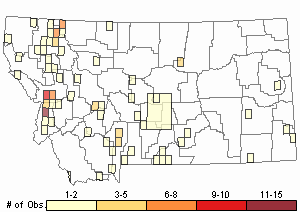
Recency
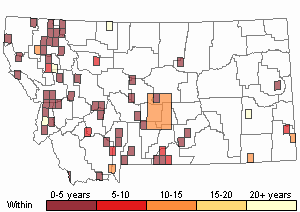
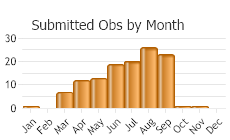
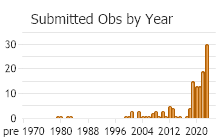
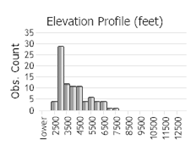 (Observations spanning multiple months or years are excluded from time charts)
(Observations spanning multiple months or years are excluded from time charts)
Migration
Migratory to some degree; a few mass movements documented, some individuals move at least 70 km, others wander southward irregularly, yet others may make seasonal elevational movements (Scott 1986; Shapiro 1986; Opler and Wright 1999).
Habitat
Streamcourses, riparian areas, montane forest openings, woodlands, city parks (Scott 1986, Opler and Wright 1999; Glassberg 2001; Pyle 2002). In Glacier National Park, Montana reported in montane xeric and mesic meadows (Debinski 1993); woodlands, streamsides, mountain parks in Greater Yellowstone Ecosystem (Debinski and Pritchard 2002).
Food Habits
Larval food plants include Acer, Alnus, Betula (several species), Celtis, Fraxinus, Humulus, Morus, Ostrya, Populus (several species), Pyrus, Rosa, Rubus, Rumex, Salix (several species), Sorbus, Spirea, Tilia, and Ulmus (Scott 1986, 1992, 2006). Adults feed on flower nectar (including Arctostaphylos, Asclepias, Chrysothamnus, Cirsium, Dirca, Physocarpus, Prunus, Salix, Tilia), tree sap, rotten fruit, and mud (Scott 1986, 2014; Tooker et al. 2002).
Reproductive Characteristics
Females lay eggs in single layer clusters (up to 250 eggs) circling near tip of host plant twig, rarely on leaves (Scott 1986, 1992, 2006). Eggs hatch in about 5-10 days (depending on temperature). Larvae develop rapidly, pupating about 16 days after egg-hatch, adults eclose (emerge from pupae) in another 12 days. Larvae highly gregarious, surrounded in a silk nest as L1-L3 instars, mature L5 instars leave host plant before pupating, hibernate (overwinter) as adults (Scott 1986; James and Nunnallee 2011). Males territorial, perch on branches from mid-day to late afternoon in valley bottoms, swales, trails, stream courses, to await passage of females; patrol every few minutes (Scott 1975b, 1986; Bitzer and Shaw 1983).
Stewardship Responsibility
References
- Literature Cited AboveLegend:
 View Online Publication
View Online Publication Bitzer, R.J. and K.C. Shaw. 1983. Territorial behavior of Nymphalis antiopa and Polygonia comma (Nymphalidae). Journal of the Lepidopterists' Society 37:1-13.
Bitzer, R.J. and K.C. Shaw. 1983. Territorial behavior of Nymphalis antiopa and Polygonia comma (Nymphalidae). Journal of the Lepidopterists' Society 37:1-13. Brown, F.M. 1957. Colorado Butterflies. Proceedings; Numbers Three through Seven. Denver Museum of Natural History, Denver, Co.
Brown, F.M. 1957. Colorado Butterflies. Proceedings; Numbers Three through Seven. Denver Museum of Natural History, Denver, Co. Debinski, D. 1993. Butterflies of Glacier National Park, Montana. Occasional Papers of the Museum of Natural History, the University of Kansas, Lawrence, Kansas. No. 159: 1-13.
Debinski, D. 1993. Butterflies of Glacier National Park, Montana. Occasional Papers of the Museum of Natural History, the University of Kansas, Lawrence, Kansas. No. 159: 1-13. Debinski, D.M. and J.A. Pritchard. 2002. A field guide to the butterflies of the Greater Yellowstone Ecosystem. Lanham, MD: Roberts Rinehart Publishers. 107 p.
Debinski, D.M. and J.A. Pritchard. 2002. A field guide to the butterflies of the Greater Yellowstone Ecosystem. Lanham, MD: Roberts Rinehart Publishers. 107 p. Ferris, C.D. and F.M. Brown (eds). 1981. Butterflies of the Rocky Mountains. Univ. of Oklahoma Press. Norman. 442 pp.
Ferris, C.D. and F.M. Brown (eds). 1981. Butterflies of the Rocky Mountains. Univ. of Oklahoma Press. Norman. 442 pp. Glassberg, J. 2001. Butterflies through Binoculars: A Field Guide to the Butterflies of Western North America. Oxford University Press.
Glassberg, J. 2001. Butterflies through Binoculars: A Field Guide to the Butterflies of Western North America. Oxford University Press. James, D.G. and D. Nunnallee. 2011. Life histories of Cascadia butterflies. Corvallis, OR: Oregon State University Press. 447 p.
James, D.G. and D. Nunnallee. 2011. Life histories of Cascadia butterflies. Corvallis, OR: Oregon State University Press. 447 p. Kohler, S. 1980. Checklist of Montana Butterflies (Rhopalocera). Journal of the Lepidopterists' Society 34(1): 1-19.
Kohler, S. 1980. Checklist of Montana Butterflies (Rhopalocera). Journal of the Lepidopterists' Society 34(1): 1-19. Opler, P.A. and A.B. Wright. 1999. A field guide to western butterflies. Second edition. Peterson Field Guides. Houghton Mifflin Company, Boston, Massachusetts. 540 pp.
Opler, P.A. and A.B. Wright. 1999. A field guide to western butterflies. Second edition. Peterson Field Guides. Houghton Mifflin Company, Boston, Massachusetts. 540 pp. Opler, P.A., K. Lotts, and T. Naberhaus, coordinators. 2010. Butterflies and moths of North America. Big Sky Institute, Bozeman, MT. Available at: www.butterfliesandmoths.org (Accessed 15 June 2015).
Opler, P.A., K. Lotts, and T. Naberhaus, coordinators. 2010. Butterflies and moths of North America. Big Sky Institute, Bozeman, MT. Available at: www.butterfliesandmoths.org (Accessed 15 June 2015). Pyle, R.M. 2002. The butterflies of Cascadia: a field guide to all the species of Washington, Oregon, and surrounding territories. Seattle Audubon Society, Seattle, Washington. 420 pp.
Pyle, R.M. 2002. The butterflies of Cascadia: a field guide to all the species of Washington, Oregon, and surrounding territories. Seattle Audubon Society, Seattle, Washington. 420 pp. Scott, J.A. 1975b. Mate-locating behavior of western North American butterflies. Journal of Research on the Lepidoptera 14:1-40.
Scott, J.A. 1975b. Mate-locating behavior of western North American butterflies. Journal of Research on the Lepidoptera 14:1-40. Scott, J.A. 1986. The butterflies of North America: a natural history and field guide. Stanford University Press, Stanford, California.
Scott, J.A. 1986. The butterflies of North America: a natural history and field guide. Stanford University Press, Stanford, California. Scott, J.A. 1992. Hostplant records for butterflies and skippers (mostly from Colorado) 1959-1992, with new life histories and notes on oviposition, immatures, and ecology. Papilio new series #6. 185 p.
Scott, J.A. 1992. Hostplant records for butterflies and skippers (mostly from Colorado) 1959-1992, with new life histories and notes on oviposition, immatures, and ecology. Papilio new series #6. 185 p. Scott, J.A. 2006. Butterfly hostplant records, 1992-2005, with a treatise on the evolution of Erynnis, and a note on new terminology for mate-locating behavior. Papilio new series #14. 74 p.
Scott, J.A. 2006. Butterfly hostplant records, 1992-2005, with a treatise on the evolution of Erynnis, and a note on new terminology for mate-locating behavior. Papilio new series #14. 74 p. Scott, J.A. 2014. Lepidoptera of North America 13. Flower visitation by Colorado butterflies (40,615 records) with a review of the literature on pollination of Colorado plants and butterfly attraction (Lepidoptera: Hersperioidea and Papilionoidea). Contributions of the C.P. Gillette Museum of Arthopod Diversity. Fort Collins, CO: Colorado State University. 190 p.
Scott, J.A. 2014. Lepidoptera of North America 13. Flower visitation by Colorado butterflies (40,615 records) with a review of the literature on pollination of Colorado plants and butterfly attraction (Lepidoptera: Hersperioidea and Papilionoidea). Contributions of the C.P. Gillette Museum of Arthopod Diversity. Fort Collins, CO: Colorado State University. 190 p. Scott, J.A. and G.R. Scott. 1978. Ecology and distribution of the butterflies of southern central Colorado. Journal of Research on the Lepidoptera 17(2): 73-128.
Scott, J.A. and G.R. Scott. 1978. Ecology and distribution of the butterflies of southern central Colorado. Journal of Research on the Lepidoptera 17(2): 73-128. Shapiro, A.M. 1986. Seasonal phenology and possible migration of the mourning cloak butterfly Nymphalis antiopa (Lepidoptera: Nymphalidae) in California. Great Basin Naturalist 46(1): 112-116.
Shapiro, A.M. 1986. Seasonal phenology and possible migration of the mourning cloak butterfly Nymphalis antiopa (Lepidoptera: Nymphalidae) in California. Great Basin Naturalist 46(1): 112-116. Stanford, R.E. and P.A. Opler. 1993. Atlas of western USA butterflies: including adjacent parts of Canada and Mexico. Unpubl. Report. Denver and Fort Collins, Colorado 275 pp.
Stanford, R.E. and P.A. Opler. 1993. Atlas of western USA butterflies: including adjacent parts of Canada and Mexico. Unpubl. Report. Denver and Fort Collins, Colorado 275 pp. Threatful, D.L. 1988. A list of the butterflies and skippers of Mount Revelstoke and Glacier National Parks, British Columbia, Canada (Lepidoptera). Journal of Research on the Lepidoptera 27(3-4): 213-221.
Threatful, D.L. 1988. A list of the butterflies and skippers of Mount Revelstoke and Glacier National Parks, British Columbia, Canada (Lepidoptera). Journal of Research on the Lepidoptera 27(3-4): 213-221. Tooker, J.F., P.F. Reagel, and L.M. Hanks. 2002. Nectar sources of day-flying lepidoptera of central Illinois. Annals of the Entomological Society of America 95(1): 84-96.
Tooker, J.F., P.F. Reagel, and L.M. Hanks. 2002. Nectar sources of day-flying lepidoptera of central Illinois. Annals of the Entomological Society of America 95(1): 84-96.
- Additional ReferencesLegend:
 View Online Publication
View Online Publication
Do you know of a citation we're missing? Allen, T.J., J.P. Brock, and J. Glassberg. 2005. Caterpillars in the field and garden: a field guide to the butterfly caterpillars of North America. Oxford University Press.
Allen, T.J., J.P. Brock, and J. Glassberg. 2005. Caterpillars in the field and garden: a field guide to the butterfly caterpillars of North America. Oxford University Press. Brock, J.P. and K. Kaufman. 2003. Kaufman Field Guide to Butterflies of North America. Houghton Mifflin Company, New York, NY 284 pp.
Brock, J.P. and K. Kaufman. 2003. Kaufman Field Guide to Butterflies of North America. Houghton Mifflin Company, New York, NY 284 pp. Caruthers, J.C., and D. Debinski. 2006. Montane meadow butterfly species distributions in the Greater Yellowstone Ecosystem. University of Wyoming National Park Service Research Center Annual Report, 2006. Vol. 30, Art. 14. 85-96.
Caruthers, J.C., and D. Debinski. 2006. Montane meadow butterfly species distributions in the Greater Yellowstone Ecosystem. University of Wyoming National Park Service Research Center Annual Report, 2006. Vol. 30, Art. 14. 85-96. Forister, M.L., C.A. Halsch, C.C. Nice, J.A. Fordyce, T.E. Dilts, J.C. Oliver, K.L. Prudic, A.M. Shapiro, J.K. Wilson, J. Glassberg. 2021. Fewer butterflies seen by community scientists across the warming and drying landscapes of the American West. Science 371:1042-1045.
Forister, M.L., C.A. Halsch, C.C. Nice, J.A. Fordyce, T.E. Dilts, J.C. Oliver, K.L. Prudic, A.M. Shapiro, J.K. Wilson, J. Glassberg. 2021. Fewer butterflies seen by community scientists across the warming and drying landscapes of the American West. Science 371:1042-1045. Forister, M.L., E.M. Grames, C.A. Halsch, K.J. Burls, C.F. Carroll, K.L. Bell, J.P. Jahner, et al. 2023. Assessing risk for butterflies in the context of climate change, demographic uncertainty, and heterogeneous data sources. Ecological Monographs 93(3):e1584. https://doi.org/10.1002/ecm.1584
Forister, M.L., E.M. Grames, C.A. Halsch, K.J. Burls, C.F. Carroll, K.L. Bell, J.P. Jahner, et al. 2023. Assessing risk for butterflies in the context of climate change, demographic uncertainty, and heterogeneous data sources. Ecological Monographs 93(3):e1584. https://doi.org/10.1002/ecm.1584 Guppy, C.S. and J.H. Shepard. 2001. Butterflies of British Columbia: including western Alberta, southern Yukon, the Alaska Panhandle, Washington, northern Oregon, northern Idaho, northwestern Montana. UBC Press (Vancouver, BC) and Royal British Columbia Museum (Victoria, BC). 414 pp.
Guppy, C.S. and J.H. Shepard. 2001. Butterflies of British Columbia: including western Alberta, southern Yukon, the Alaska Panhandle, Washington, northern Oregon, northern Idaho, northwestern Montana. UBC Press (Vancouver, BC) and Royal British Columbia Museum (Victoria, BC). 414 pp. Layberry, R.A., P.W. Hall, and J.D. LaFontaine. 1998. The Butterflies of Canada. University of Toronto Press. 280 pp. + color plates.
Layberry, R.A., P.W. Hall, and J.D. LaFontaine. 1998. The Butterflies of Canada. University of Toronto Press. 280 pp. + color plates. Maxell, B.A. 2016. Flammulated Owl surveys on the Big Timber, Bozeman, Gardiner and Livingston Ranger Districts of the Custer Gallatin National Forest: 2013. Report to Custer Gallatin National Forest. Montana Natural Heritage Program. Helena, MT. 27pp + appendices.
Maxell, B.A. 2016. Flammulated Owl surveys on the Big Timber, Bozeman, Gardiner and Livingston Ranger Districts of the Custer Gallatin National Forest: 2013. Report to Custer Gallatin National Forest. Montana Natural Heritage Program. Helena, MT. 27pp + appendices. Sater, S. 2022. The insects of Sevenmile Creek, a pictorial guide to their diversity and ecology. Undergraduate Thesis. Helena, MT: Carroll College. 242 p.
Sater, S. 2022. The insects of Sevenmile Creek, a pictorial guide to their diversity and ecology. Undergraduate Thesis. Helena, MT: Carroll College. 242 p.
- Web Search Engines for Articles on "Mourning Cloak"
- Additional Sources of Information Related to "Insects"





